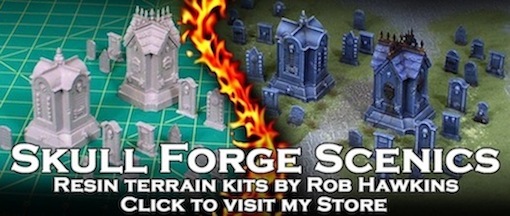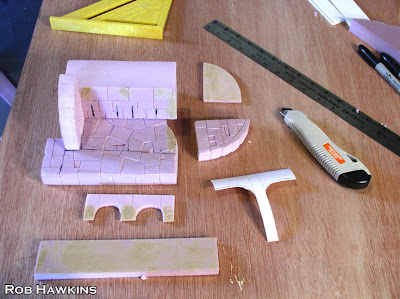Friday, July 27, 2012
Sunday, July 22, 2012
Wrath of Kings Diorama: Part 3
Note: This terrain project is progressing at a brisk pace, so I may be overlooking certain details that would get better coverage in a "proper" tutorial. I also haven't had time to answer any of the questions people have been asking in the comments, but please don't feel like I'm neglecting them. If you have any questions about the process or techniques, please continue to ask them in the comments section or email me, and I'll compile them into a Q&A post after the project is complete.
This week saw the the major construction on the Wrath of Kings diorama winding down, and the main tower shaping up.
The Rooftops
With the roof shapes cut and coated with Liquid Nails, I began framing out the roof timbers. I use basswood, rather than balsa because the basswood is much sturdier, and not much more expensive. The thicker strips of basswood cover the edges of the foamcore roofs, while the thinner strips are used for the planking on the sides of the roof.
The shingles are cut from thick artboard. Each strip is 1 inch wide, with the shingles cut about halfway through. The edges of some shingle were irregularly cut to create a little variety.
These strips were glued in overlapping rows, starting at the bottom and working toward the apex of the roof. Individual shingles, cut from thinner cardboard, were folded over the corners.
The chimneys were made by cutting a square length of foam, and shaping it round on the belt sander. To add structural support, wooden skewers were pushed through the length of the chimney.
Each chimney will be cut with a stone pattern and attached to the rooftop.
The Backside
I continued the rocks around the back of the city, and began constructing the tower. Like the crayon tower, this thicker tower was made by covering a tapered plastic vase with card "stones."
Here's the tower with the rocks piled up around its base and continuing on to the opposite side of the table.
With the rocks in place, I filled in the crevices with some smaller stones, using a combination of different grades of ballast and play sand.
The Main Tower
Like the other large structures, the main round tower was cut from layers of 2-inch insulation foam, and given a stone texture. The roofs were beveled and coated with Liquid Nails.
To this central mass, I gradually built up the other buildings. I'm still searching for something to use as the elemental's head, but I may end up just shaping it out of pink foam.
From overhead, you can see the layout of the paths and outer buildings. The black dots indicate where the dead trees will go.
After the last of the roof shingles are added, it will be time for the windows. I've made a few window boxes out of styrene strips and Aves Epoxy Sculpt. I'll use RTV silicone to create a mold and resin cast enough copies of the windows to fill out the buildings.
Check out the rest of the project journal:
Part 1: Shaping the Hillside
Part 2: Building the Goritsi City
Part 4: Resin Casting Windows
Part 5: Painting and Final Details
'Til next time!
Sunday, July 15, 2012
Wrath of Kings Diorama: Part 2
I've been asked a few questions about the footprint (something I omitted from the previous post). The table is 3' x3' with the height capping out around 24 inches.
I've also gotten permission to post the concept art that I'm working from. This is one of the Goritsi cities, which have these shadowy elementals lurking within.
Building the Goritsi City
The city will serve as the backdrop for the action, which will take place in the foreground of the diorama.
As I mentioned last time, The building foundations were set into the hillside using 2-inch foam. These change position a few times over the course of the build. In fact, if you look at the bottom, you'll notice that the buildings on the left are vastly different compared to this early stage.
I begin with the core structure, and work around it, gradually building up the levels and details. The large tower is made from layers of 2-inch foam, cut into circles and sanded smooth. Here, you can see the foam core roofs starting to take shape. The seams in the hillside have also been covered with wood filler putty.
For the stonework, I cut the individual stones with a hobby knife, and trace over the cuts with a wood pencil. Then each stone is pressed with my thumb and the pencil's eraser to create an uneven surface that will drybrush up beautifully.
At the top of the city is a pair of arches with two statues. To create the arch, I built the floor and wall, and created two curved pieces to go on each end. The backs of the pink insulation foam were coated with Liquid Nails. When the Liquid Nails dries, the surfaces can be super glued together. Most of the larger pieces are joined using only Liquid Nails, but on the smaller parts it's easier to use super glue for an instant bond. I simply cut the parts, coat them, and work on something else as they dry. Then the pieces go together in a snap.
The center arch is made using a piece of segmented art board.
The foam stones are then glued over this to form the arch. Before attaching the arch, I coated the interior with a wash of wood glue, and then black latex paint to protect and basecoat it. The entire table will receive this treatment prior to painting, but I did this interior portion now because it would have been difficult to reach with the arch in place.
The towers on the left, like the large round tower, were made by stacking layers of foam, secured with Liquid Nails.
Once the adhesive was dry, I sanded them into shape on a belt sander.
The belt sander creates a pretty rough surface, so I "polish" it with a small handheld sander with a fine grit. This little sander is also used to remove the "crispy" surface of the insulation foam. (The flat sides of the insulation have a bit of a shell, which makes cutting the stones difficult; the surface tends to crack and is a little to smooth.)
Here are the sanded towers, on the table.
For the tower rooftops, I use insulation foam, coated with Liquid Nails. The coating will protect the foam, and I can super glue shingles right onto the surface.
In this shot, I've cut out the arch for the high doorway.
Then, foam stones were glued around the frame.
Building round towers is always a challenge. I picked up this crayon bank, which was the correct size, and even has a conical shape for the roof (although that cone will get cut down significantly). The smooth plastic surface has been sanded rough and coated with Liquid Nails.
This was the point when I realized that the buildings on the left weren't quite right, so I altered their angles to get their positioning closer to that of the concept art.
I refer to this as the "jigsaw puzzle building." Four pieces of foam, and lots of minor adjustments to get it into the proper shape. (In this image it's still not quite finished.)
The Gotitsi city is shaping up quite nicely. The crayon bank has been covered with individually cut card "stones" and all the roofs are awaiting their shingles. Coming up, I'll tackle the large tower.
Check out the rest of the project journal:
Part 1: Shaping the Hillside
Part 3: Rooftops and Chimneys
Part 4: Resin Casting Windows
Part 5: Painting and Final Details
'Til next time!
Subscribe to:
Posts (Atom)

























































